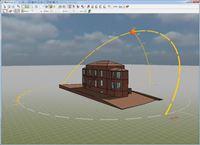Improving Energy Modeling Techniques for Historic Buildings Using Preliminary Verification Methods

Often for historic buildings air infiltration and thermal resistance values for the envelope are not well known and can significantly influence accuracy of building energy simulations as well as the actual energy performance of a building.
This paper details some of the methods used in a funded research project to improve energy modeling for historic buildings using low cost preliminary verification methods. By using in-situ non-destructive testing methods to measure heat flux and surface temperatures more accurate thermal resistance values were determined for two buildings. By using door blower pressurization tests the air tightness of both buildings were measured allowing for a more accurate understanding of air infiltration rates. By using these field derived parameters building energy simulations with calibrated input parameters were created and compared with baselines (using standard assumptions for materials and air infiltration) to study the significance of preliminary verification methods on the predictive nature and accuracy of building energy simulations for historic buildings. Using this method of modeling coupled with field testing can improve confidence and accuracy in future building energy simulations for historic buildings and ultimately help provide more meaningful energy data in the decision-making process for owners and operators of historic buildings.
keywords: historic buildings, energy modeling, heat flux, in-situ testing, air tightness


Add comment
Log in to post comments